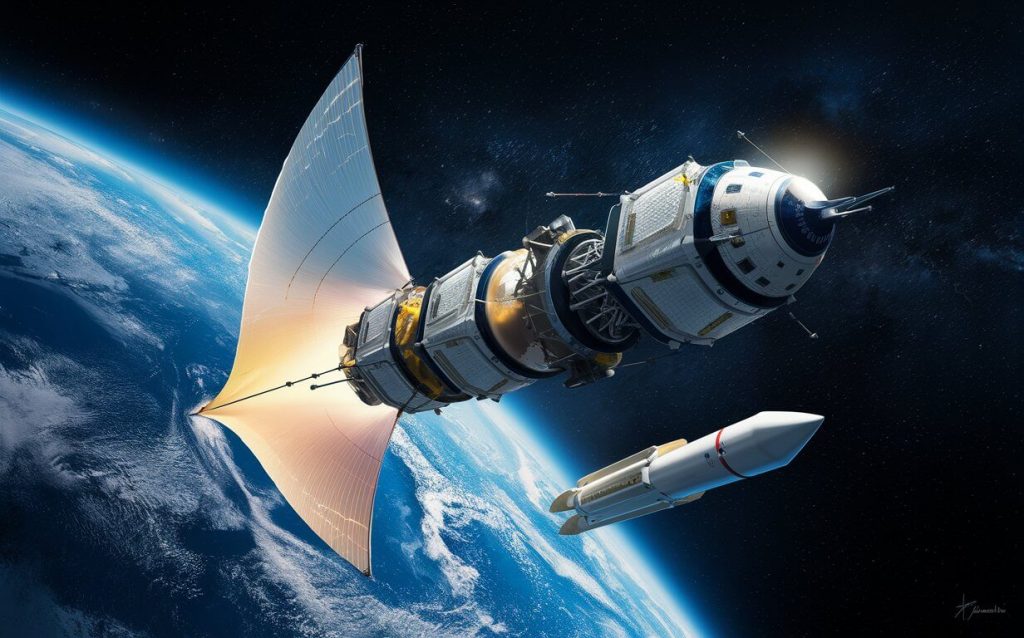As humanity ventures into the vast expanse of space, our curiosity has led to remarkable discoveries rewriting the textbooks on planetary formation and astrobiology. From the majestic gas giants dotting our solar system’s horizon to the intricate dance of celestial bodies in distant galaxies, our quest for knowledge propels us to explore the cosmos like never before.
With each breakthrough, we push the boundaries of what we thought possible, from harnessing nuclear power on Mars to deciphering dark matter’s secrets. As we continue this odyssey into the unknown, our understanding of space and its mysteries will only grow more profound.
The Quest for Gravity’s Secrets: Unveiling the Mysteries of General Relativity
During our journey through the latent space, we’ve pondered gravity and its intricacies, long leaving many astounded by their mysteries. As we delve deeper into understanding these puzzles, it becomes essential to grasp Einstein’s groundbreaking work in developing general relativity. This comprehension will aid in revealing the buried concepts.
Examining Einstein’s personal experiences and professional background can provide valuable insights into his creative problem-solving process. Studying the influences that shaped him might unveil some of gravity’s defying mysteries. Exploring alternative perspectives on general relativity could reveal previously unknown aspects hidden beneath its surface.
This inquiry may lead to a deeper understanding of gravity’s secrets. Analyzing connections between Einstein’s work and contemporaries’ contributions can provide a holistic comprehension of the theory’s fabric.
How Modern Astrophysics Forges a New Path to Understanding Gravitational Forces
Despite gravitational forces being a cornerstone in modern astrophysics for decades, recent discoveries and advancements have forced scientists to re-examine their theories about these fundamental forces.
While many researchers believe understanding gravitational waves will be crucial in unraveling some of its secrets, scientists are working tirelessly to develop new technologies capable of detecting such faint signals from the cosmos. Meanwhile, simulations and theoretical models continue refining our comprehension of gravity’s influence on large-scale cosmic structures.
Some astrophysicists also propose that exploring dark matter’s properties could shed light upon gravity’s hidden secrets. By studying its effects in various astronomical contexts, experts hope to better grasp how this mysterious force operates within galaxies.
For instance, certain phenomena occurring at very small scales or extremely high energies have led scientists down a new path toward understanding gravitational forces more comprehensively. Researchers are now examining these tiny particles and the extreme conditions required for their existence.
Other astrophysicists emphasize that exploring alternative theories of gravity could help unravel some of its remaining mysteries. Some researchers suggest focusing on modified gravitation models to better grasp how gravity influences cosmic structures. The interconnected fields poised at the edge of major breakthroughs will ultimately shed light upon our comprehension of these fundamental forces.
The Role of Dark Matter and Its Implications on Our Quest for Gravity’s Secrets
Every discovery of dark matter’s role in gravity has illuminated its profound influence on our understanding of the universe. As scientists have delved deeper into its secrets, they’ve found that it’s not just a passive companion to visible matter but an active participant shaping galaxy evolution.
Dark matter’s gravitational pull helps explain why galaxies appear as massive as they do. It also accounts for the discrepancy in observed velocities within these galactic giants. Moreover, dark matter assists in creating strong enough gravitational forces to warp space-time around them.
However, its most intriguing implication lies not only in how it interacts with normal matter but also in the creative ways scientists have found themselves exploring alternative theories of gravity beyond Einstein’s general relativity.
For instance, MOND or emergent gravity models propose that dark matter might be more than just a new type of particle – it could be an effect from complex astrophysical processes. These ideas challenge our understanding of the gravitational force itself, inviting further scrutiny into these mysteries.
Unveiling Dark Matter’s Mysteries: Understanding Dark Matter’s Role in Shaping Galaxy Clusters
While some believe dark matter is nothing more than an artifact from incorrect cosmological models, others argue it could be the key to explaining why certain types of galaxies behave differently from one another. Understanding how these distinct behaviors originate may depend on identifying novel features within gravity itself.
In order to shed light on this enigma, astronomers have turned their attention back towards understanding dark matter’s role in shaping galaxy clusters. This means re-examining assumptions regarding galaxies’ distributions and considering alternative approaches that can reveal its underlying role in shaping these massive structures of the universe. Moving forward will involve exploring novel features within gravity itself, such as modifications in gravitational force or new dimensions beyond our own.
Investigating the Relationship Between Dark Matter and Ordinary Gravity
If dark matter didn’t exist, galaxies would likely evolve in ways vastly different from what we observe today. Without it, their stars and gas might not hold together by gravity alone, resulting in a collapsing single point galaxy.
It seems strange to imagine galaxies without dark matter’s influence. Still, its presence affects how galaxies form and evolve. Dark matter’s unique properties allow normal gravity to behave differently over larger distances – it’s stronger at greater separations. This difference between ordinary gravity and dark matter has significant consequences for our understanding of galaxy assembly.
If we analyze these gravitational forces separately within galactic formation, it seems likely that without dark matter, galaxies might never have formed or may have collapsed early on due to insufficient normal gravity for stabilization. The implications this has on our comprehension of cosmic history are considerable – it suggests dark matter plays a vital role in shaping large-scale structure in the universe as it helps form clusters and maintain overall cosmic scales during these periods.
Implications of Dark Matter on Our Current Understanding of Cosmic Scales
Through gravitational interactions and galaxy clustering, I’ve found that Dark Matter’s mystifying presence has profound implications for our comprehension of cosmic scales. Dark Matter’s influence on large-scale structures is evident in the distribution and motion patterns within clusters. Its gravity drives massive galaxies toward each other, shaping galaxy distributions and velocities. Conversely, its absence leaves these systems eerily silent.
The observed discrepancies between theoretical predictions and observational data reveal Dark Matter’s existence. The Sloan Digital Sky Survey’s rich galaxy catalogs have led us to discover that this enigmatic component accounts for a significant portion of gravitational interactions within these structures.
While Standard Model particles interact through electroweak forces, Dark Matter particles evade detection by not emitting or absorbing photons. This fundamental distinction between particle physics and gravitational collapse has far-reaching implications on our understanding of galaxy clusters and the cosmos as a whole.
The search for extraterrestrial life beyond Earth
Detecting life beyond Earth could require various strategies and technologies, depending on whether we’re searching for signals in various formats.
With the vastness of space and time that our universe has at its disposal, detecting life beyond Earth could require a range of strategies and technologies. We might detect extraterrestrial signals or signs through different channels:
– Detecting sounds from another civilization’s technological emissions, like an astrophysical anomaly such as a supernova explosion
– Sensing life through astronomical observations of exoplanets with Earth-like conditions
– Detecting signs of life through spectrographic analysis and astrometric measurements inferring the presence of organic molecules essential for living organisms
– Monitoring cosmic background radiation or searching within starlight itself
Detection and ‘Signaling’ Strategies for Contact
Many experts agree that if we find evidence of extraterrestrial intelligence, it will likely be detected through a combination of advanced technologies. This includes sending out probes or signals into space and actively listening for any responses.
Detection strategies are crucial in identifying intelligent life elsewhere. The most promising approach involves searching for signs of intelligent life within our universe itself. We’ll need to employ techniques to detect potential signals coming from outside our planet.
The first step involves broadcasting information on multiple frequencies, like TV channels, so extraterrestrials could find us if they’re listening. This method is deemed effective in communicating with intelligent life beyond Earth.
While detection strategies are important, many scientists emphasize preparing not only to detect signs but also actively listen and respond once detection is confirmed. There’s a chance of finding intelligent life where astrobiologists believe it would thrive most, such as moons orbiting cooler stars than our sun.
Is There Enough Potential For Extraterrestrial Life Beyond Earth To Affect Our Understanding Of Gravity And Dark Matter?
Often, as we gaze up at the night sky, our minds can’t help but wander to the existence of other life forms beyond our planet. It’s fascinating to consider that intelligent beings living in another galaxy or universe might influence our understanding of gravity and dark matter.
While we ponder the mysteries of the cosmos, some scientists have proposed an intriguing theory – aliens could be manipulating gravitational forces on their own planets, affecting how we grasp these cosmic phenomena. Others suggest extraterrestrial life is warping dark matter around their galaxies, impacting how they perceive these enigmatic entities in space.
Propulsion Technologies for Deep Space Exploration
As scientists delve into the possibilities of propulsion technologies for deep space exploration, they investigate innovative methods tapping into quantum fluctuations and gravitational waves.
Harnessing Quantum Fluctuations: The tiny variations in energy density within spacetime, known as quantum fluctuations, can potentially generate thrust. By creating miniature black holes or exploiting exotic matter states within these regions, spacecraft could harness the immense energy released for propulsion.
Tapping into Gravitational Waves: Gravitational waves are spacetime ripples caused by massive cosmic events like supernovae and binary star mergers. By detecting these waves using sensitive instruments, researchers believe spacecraft could potentially “surf” these gravitational slingshot effects to accelerate or use the energy released during wave detection.
Incorporating both principles into propulsion technology would require significant miniaturization advancements and compacting advanced propulsion systems. Theoretically, such concepts could revolutionize deep space exploration by leveraging nature’s gravitational forces for interstellar travel.
Propelling Through the Vacuum with Magnetic Coils and Exotic Matter
Propelling through the vacuum poses significant challenges. One promising approach involves harnessing magnetic coils and exotic matter. Researchers have made groundbreaking discoveries about magnetic fields’ strength in high-energy particle collisions, leading scientists to explore manipulating gravity waves generated by displaced mass within spacetime itself.
These findings suggest propulsion systems could harness energy released during distortions through exotic matter interactions. The idea relies on understanding quantum phenomena during gravitational wave generation, effectively bending spacetime geometry to create localized distortion effects.
Suppose we could generate those artificial gravity-like forces and propagate them through magnetic coils within a high-energy particle and exotic matter environment. This setup would theoretically allow propulsion systems to accelerate charged particles, propelling spacecraft across vast distances and overcoming vacuum limitations on classical methods.
For instance, magnetized plasma thrusters could accelerate charged particles through exotic matter interactions, enabling fast and efficient acceleration capabilities. The concept relies heavily on understanding quantum phenomena during gravitational wave generation. By carefully crafting distortions in a magnetic field using high-energy particle collisions, researchers theorize propulsion systems could harness energy released through exotic matter interactions.
Exploring Alternate Dimensions via Folded Space-Time Strategies
Through the dimensional fabric of our cosmos lies a hidden secret – propulsion technologies for deep space exploration. Propelling ourselves through the vast expanse requires optimizing fold dynamics, where we harness localized spacetime fabric distortions to generate stable wormhole thrust vectors for traversing vast distances quickly.
By leveraging gravitational waves’ power and quantum fluctuations within black holes, we can create a propulsive force sufficient to bend spacetime curvature in our favor. In this realm lies the potential for folded-spacetime strategies, where spacetime distortions serve as propulsion systems – all while maintaining spatial integrity through strategic dimensional resonance.
As we venture into the unknown expanses, it’s crucial our path is paved with a deeper understanding of these propulsion technologies. Only by navigating spacetime fabric’s complexities can we unlock its secrets and push beyond our current knowledge boundaries.
Overcoming Technological Barriers for Deep Space Exploration
NASA’s biggest challenge in developing a sustainable space program is finding ways to overcome technological barriers between its current capabilities and the deep space exploration vision. The hurdle will be bridged by generating reliable energy sources, developing robust communication systems, and creating habitats capable of supporting human life for extended periods.
As NASA continues this ambitious path, it has invested in new technologies such as solar-powered propulsion systems, advanced nuclear reactors, and inflatable habitat modules. These innovations could ultimately enable longer space missions requiring greater autonomy from Earth-based control centers.
Another area needing technological breakthroughs is developing robust communication networks capable of transmitting vast data across interstellar distances while minimizing latency issues. NASA explores new methods like using AI-driven signal processing algorithms and advanced antenna designs that can maintain optimal communications links amidst unpredictable space environments.
Harnessing Innovation and Collaboration in the Pursuit of New Discoveries
People have been driven to reach beyond our planet’s atmosphere for thousands of years, fueled by an innate curiosity about what lies beyond our cosmic horizon. To address reaching farther into our solar system, scientists turn to innovative technologies – robots remotely controlled from Earth or even autonomously once leaving our planet’s surface.
NASA pushes space technology’s boundaries through robotic arm advancements that can work with humans in real-time, allowing precise control from a terrestrial base or en route to other planets. Similarly, one-way trip spacecrafts have already demonstrated testing success.
With every challenge comes an opportunity for those wishing to continue exploring our solar system. As we venture further into space’s vastness, new frontiers beckon us onward – challenges testing human ingenuity’s limits and driving innovation forward once again. The future is when, not if, humanity will set foot on another planet’s surface.
Navigating Complexity and Uncertainty to Unlock Future Space Missions’ Full Potential
The challenge ahead for space exploration is navigating the complexity and uncertainty of the largely unexplored, vast cosmos – a puzzle requiring us to understand our current and future technological capabilities.
As we venture further into this uncharted territory, developing a sustainable technology infrastructure capable of supporting long-term missions is crucial. This could involve creating autonomous AI-enabled spacecraft with navigation systems that can handle unforeseen situations and adapt to new information.
But the human side shouldn’t be overlooked either. Psychological preparedness through simulation training or mental wellness checks before embarkation is essential in ensuring astronauts are better equipped to cope with stress and uncertainty during these missions.
Moving forward requires tackling unforeseen challenges head-on while navigating uncharted territories. Embracing this duality will unlock new frontiers and redefine pioneering in space exploration.
The Next Frontier of Space Exploration
As we venture into space’s vast expanse, our greatest discoveries often lie at the intersection of human curiosity and technological innovation. By embracing this synergy, we can unlock new frontiers in space exploration and redefine what it means to be a pioneer in this field.











Модные советы по созданию крутых луков на любой день.
Мнения профессионалов, события, все новые коллекции и шоу.
https://sochidaily.ru/read/2024-09-10-demna-gvasaliya-ikona-sovremennoy-mody-i-kreativnyy-revolyutsioner
Стильные заметки по созданию стильных образов на любой день.
Статьи стилистов, новости, все новые коллекции и мероприятия.
https://biiut.com/read-blog/79584